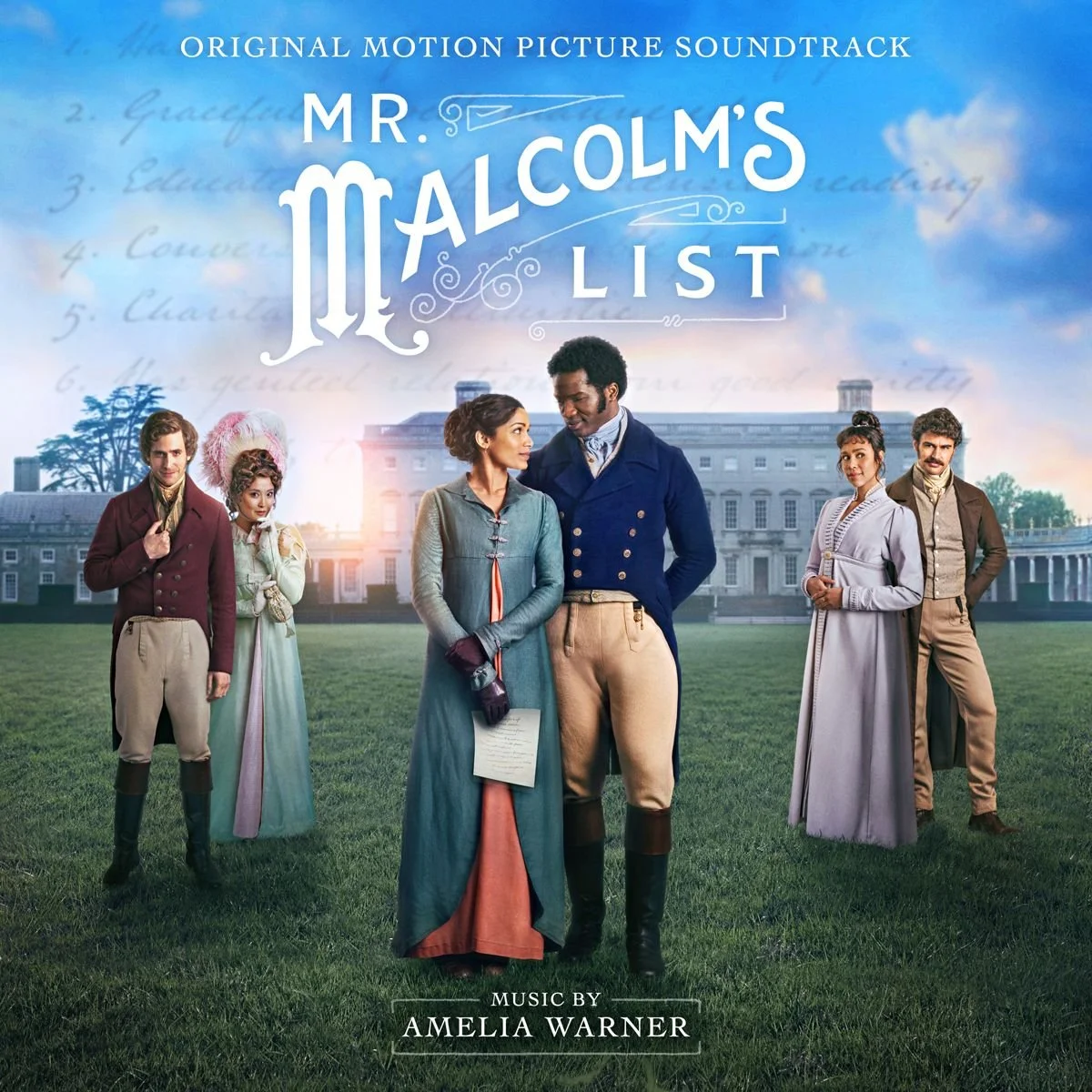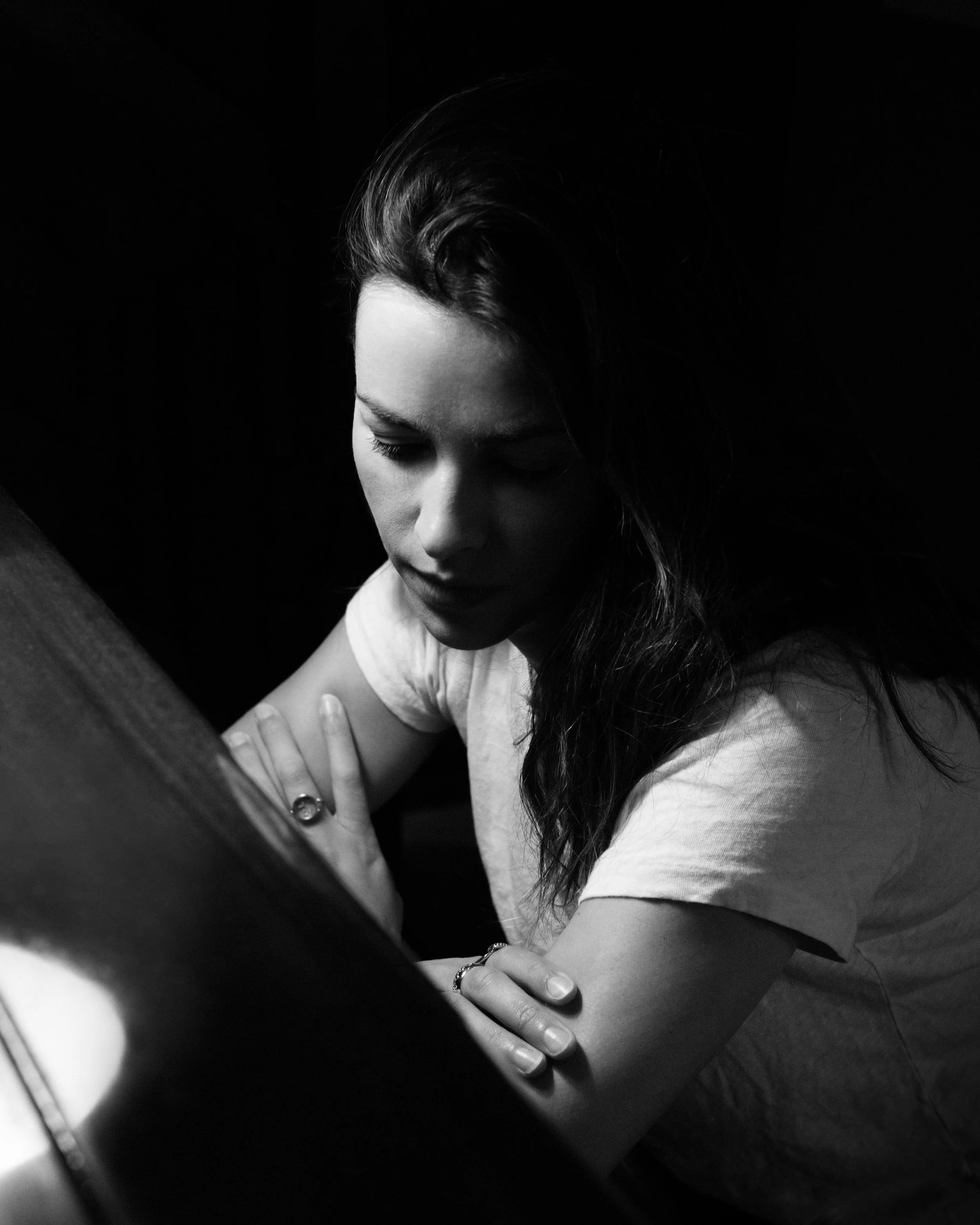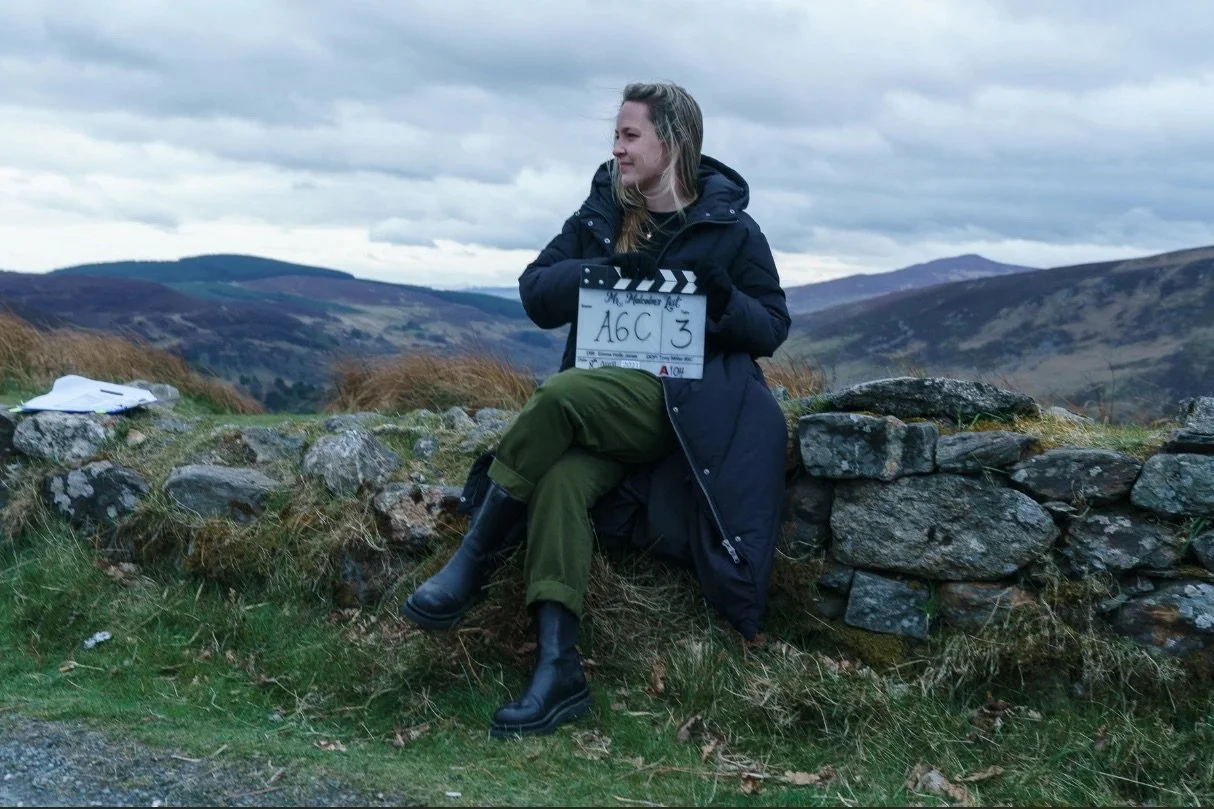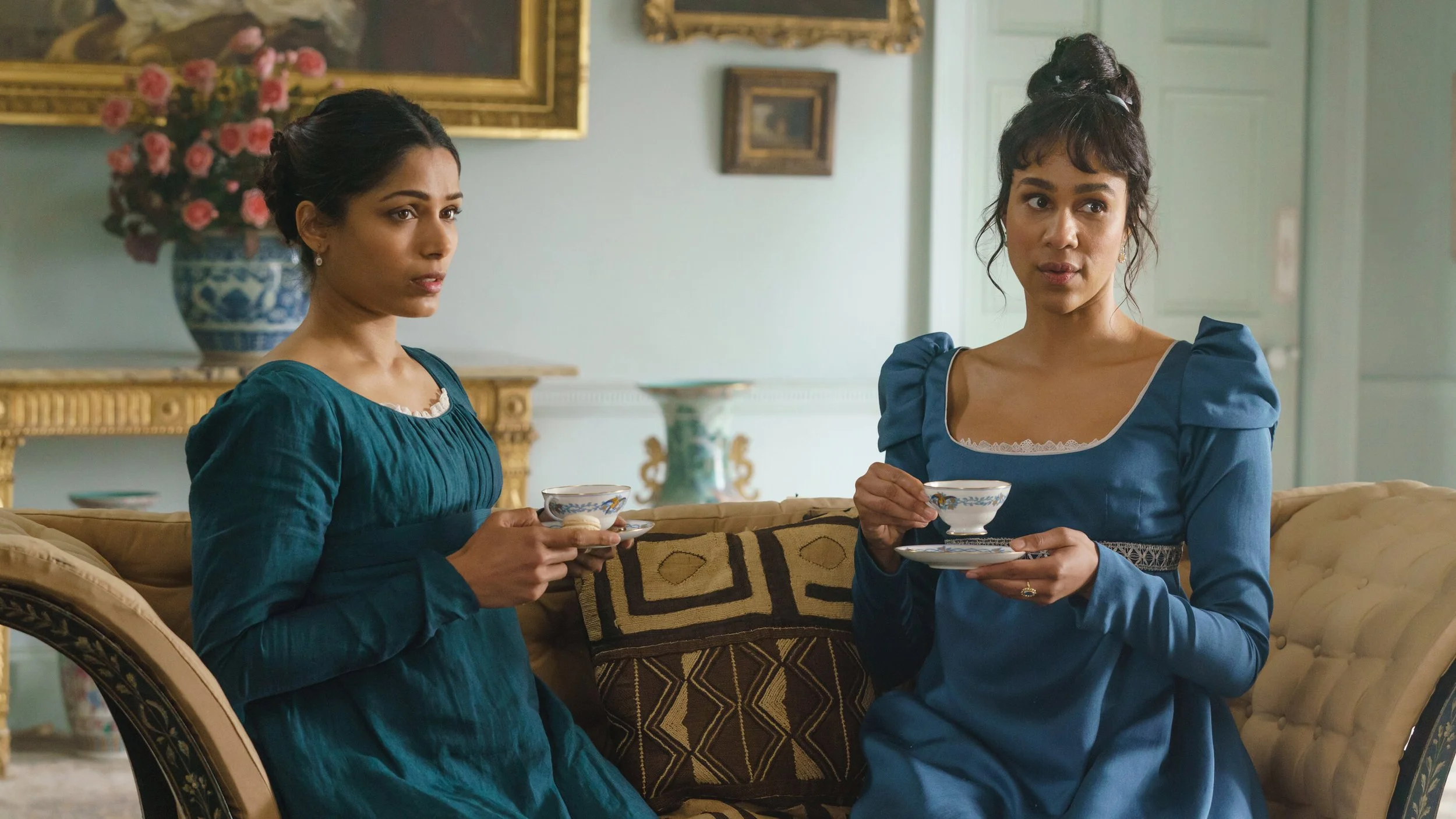Mr. Malcolm's List: Dissecting the Score by Amelia Warner
The soundtrack is out on Lakeshore Records. Listen here.
This week, we were very fortunate to re-connect with composer Amelia Warner (Wild Mountain Thyme, Mary Shelley) to talk about her most recent score to Mr. Malcolm - a period romantic comedy now in theaters. We discussed her creative process, working with director Emma Holly Jones, and what to listen for in the score. Central to this classical soundtrack is an endearing love theme that Warner created after being inspired by the script and was used to choreograph and shoot a lavish, integral ballroom scene in the film. Also, trading strings for playful and humored woodwinds, Warner's score doesn't shy away from the "fizzy, frothy fun" of the film while also providing the romantic undercurrent of the characters.
It was wonderful to connect with her again after discussing Wild Mountain Thyme, and we can’t wait to see what she has coming up next.
CineConcerts (CC): I’m really curious about, in your words, what your take is about the story of the film. It looks really fun.
Amelia Warner (AW): It’s an adaptation of a book and it’s set in Regency London, England. I suppose it’s a revenge story of sorts, it’s a romantic comedy. Julia Thistlewaite is a high society lady with really high status, she’s out and about and trying to snag an eligible bachelor and the most eligible bachelor on the scene is the son of an Earl called Mr. Malcolm. So, she manages to get a date with him and they go out and he never calls her, or the equivalent of, he never sends her a letter. So, she’s publicly rejected by him. She’s mortified and embarrassed so she enlists the help of her old childhood friend Selina who lives in the countryside, who nobody in London Society knows, brings her in, has a big old makeover, teaches her how to behave, what to wear. Because Julia discovers that Mr. Malcolm has a list of all the requirements of the perfect wife and they have to meet all these requirements. And Julia failed at, I think, the second one.
So, she has the list and she basically constructs this character that he’s going to fall in love with and at the last-minute Selina’s going to stand up and up and go “Actually, I have a list and you don’t meet the requirements.”
Then obviously Selina arrives and she’s everything that Mr. Malcolm has dreamt of, the perfect woman, beautiful, intelligent, informed, assertive, honorable, all of the things that he wanted. It all ensues from there and it’s chaos and funny.
I really enjoyed doing something that was so funny and witty and where the dialogue was just really, really buoyant. Just fun and quick. It was a really fun thing to work on.
CC: You say buoyant, which is a great word, because the score is so fun and playful, but also really emotional at times, very tender and personal. You use a lot of strings and woodwinds, but can you talk a bit about how you distilled that comedy and fun and stress—There’s a lot of stress when it comes to relationships, so how did you balance that musically?
AW: The two things that I was mainly focused on were the humor, the comedy, having this sense of fun and fears and vitality and vibrancy then also having something that felt really soulful and emotive so that you actually care. Because as much as it’s all fun and games, unless you really do care about the characters, it’s not really going to hold your interest. The performances were so great and the script was so good that I just really wanted to have this core theme that felt really pure and really honest and quite exposed. I felt like it was quite a vulnerable theme and it’s very tender and I wanted something that felt very sweet and pure.
So that was for Malcolm and Selina, because none of this is really their fault, they’ve found themselves in this situation, pawns in this game that Julia is playing, but they’re really good, honest people actually, so I wanted their theme to reflect that and to feel really truthful. And with the other stuff I wanted to try and capture, particularly Julia, her feistiness and pazazz, she’s just really funny and got this really physical performance that just really inspired me when I watched it. That’s where I started to think about doing lots of trills, these flute trills, to give it this frilly, fizziness, is the thing I was thinking about. The film’s got a lot of dialogue and there’s not a lot of space for music so it’s just finding those little cheeky moments where you could just sneak in and accentuate something, a joke or a moment. I felt like with the woodwind you could just creep in and out without being there the whole time or having to underscore everything. I just found that it was really fun writing all the stuff on the woodwind it just seemed to fit really well. I felt like I could be expressive and playful with it.
Composer Amelia Warner - photo by Clement Lauchard
CC: How large was the orchestra that you did the sessions with?
AW: I can’t actually remember, but I think there was about 40 and we did that in Budapest. And that was the other side of the score, because I knew that the film makers just wanted to add scope and some grandeur to the movie, so it was just coming in with those big, sweeping moments. So, we had a big string section in Budapest and then we did all of the soloists in London and we did kind of a, I think it might have been six players and they were almost like a woodwind group. We did all of that in London because I just really wanted to be able to be hands on for those performances because they’re so much about timing and comedy and being playful in the studio. We had quite a bit of harp as well and piano, we recorded that in London too.
Director Emma Holly Jones
CC: Emma Holly Jones is the director and this is the first time you’ve ever worked with her?
AW: Yeah.
CC: How did you get started on this project? Did she reach out to you to score the film?
AW: Weirdly, we discovered that we have some mutual friends, but we didn’t know that at the time. I think she was just given a list of names and listened to some stuff and I think that I was just lucky that she went, “yeah, okay. That’s what I want.” Wild Mountain Thyme had just come out, she listened to the score, we met in London and we went for a walk in the park and we just got on really well. When I met her, I thought, “This is going to be really interesting, this is not going to be necessarily what I’m seeing on the page. She’s going to do something with this.” She’s got really interesting vision and a strong sense of what she wanted and I was really excited about the idea of working with her.
CC: Obviously she had a template in her mind’s eye for the story and the music and how it comes together. Were you able to have a lot of composing freedom to stretch your wings a little bit and go outside of the lines?
AW: Yeah, I was. It was such an enjoyable experience because Emma knows what she wants and she’s really clear and particular and she responds very emotionally and very quickly to things. So, it wasn’t like I could just do what I wanted and she’d be like, “Yeah, I love it!” but she was very much like, “What feels right to you?” And then often she’d be like, “That’s not it. I don’t know what it is, but I haven’t heard it yet.” And she’d be really honest that she doesn’t know that much about music, I mean, she says she doesn’t, but I’m like, “Emma, you do.” She’s got great taste. She didn’t necessarily feel comfortable talking in musical terms, especially classical music. Which, again, I understood and I think that’s why we got on very well because I don’t have a classical background and I’m not someone who can talk endlessly about classical music, I really can’t, my knowledge is quite limited. So, I think we had this nice common ground where I wasn’t speaking in a way that was alienating her from music, we could just talk about it in a really emotional way. She was just great at recognizing when it worked and then also when “it’s not working, but I can’t tell you exactly why, so just keep trying.”
We got there but she really responded really strongly to the Love Theme, so when I’d written that she was just like, “That’s it!”
CC: That’s the undercurrent for the entire score, right, the Love Theme. What was the beginning of that for you, was it reading the script or was it your first conversation with her?
AW: It began, I think I’d read the script and I knew that they were shooting. She really liked the idea of the Love Theme coming into the ballroom scene. So, there’s a scene where Malcolm and Selina dance together and she wanted it to become the score. So, I knew that they wanted to have that theme when they started shooting and it was one of the first things, they were going to shoot was this ballroom scene. So, they wanted it for choreography so the pressure was a bit on to be honest about it. And I was kind of playing around, just started playing and was like, “I really like this.” But it felt too contemporary to me, felt quite modern. I wasn’t sure if it was going to be what they want, because it’s not like a big theme in a way, just some really simple piano. And I thought, “I really love this, but I’m not sure that it’s right for the period, it’s not Regency enough.”
But I kind of did it anyway, a really simple version of it, and sent it off to Emma and she just loved it. So, that was just amazing to have that and I think maybe why it probably works quite well is because it feels more like a modern arrangement, it doesn’t feel necessarily of that period, but I think that’s what she wanted. She wanted something that felt of the now.
CC: And which track, when people are listening at home to the score, is the Love Theme just purely and simply?
AW: “The Proposal” is the love theme when it comes in at the end, it’s sort of the biggest version of it and then there’s a smaller version, I think it’s called “First Meeting” and then there’s “Malcolm & Selina” which is when they dance. So, there’s a few different versions of it on the soundtrack.
CC: So, they actually choreographed and were playing your score on set?
AW: Yeah, which is so nice. And I think they played it at the end as well, there’s a big, long drone shot and I think Emma was playing then.
CC: To really put yourself out there, as a composer you’re writing things that you’re sure if they’re going to work or not, you think it is, and you do your best to answer the vision of the director. How do you grapple with, as a creative person, putting yourself out there and not knowing whether you’re defining that emotion or that request? How do you cope with the creative risk you take as a composer?
AW: I don’t know. It is risky, but I guess I’m not precious about it, so if it doesn’t work, I don’t mind and I’m really happy to start again. So, I actually don’t find it that stressful because—sometimes I’m disappointed because I love that, “Oh, what a shame.” But ultimately, I’ll end up going back and doing something and then I’ll go, “Right, that was much better.” I don’t mind if it’s not what they imagined.
There’s always that difficult bit at the beginning where creatively, you have this sense of what it should feel like and you hope and pray that the conversation you’ve had with the director are about the same thing. You just never know. In the past I’ve written quite a lot from script and that’s always been quite successful for me, usually those themes end up in the film.
Composer Amelia Warner
I just started working on something now and I’d written quite a few themes from the script and I just saw a little bit of the film the other day and I’m really off. “Oh, this is different.” It’s the first time that’s happened, but really, I was like, “No, that’s not the right feel at all.” Seeing the images and seeing the film really has changed the score I’m going to write.
So, that was a bit unusual. There’s always a bit of surprise and weird stuff that happens either way, and I much prefer writing to picture, honestly. As much as I love doing early ideas and early themes, it’s a really fun way to experiment, in the end, unless you’re really responding to stuff that you’re seeing, it’s really difficult to get it right and to know what’s going to work. I do ultimately prefer to go, “Okay, what’s there, what are we responding to.”
CC: Composing to picture is relatively rare then? You tend to sketch things out prior to seeing the cut, right?
AW: Yeah. Usually.
CC: As a composer when you read a script, musically, obviously you’re seeing images in your mind, but you’re also thinking in color and tone and textures. Like the harp and flutes for example. There might be some funny dialogue back and forth that you think about in a sort of visual sense, right? Do you go to the piano and immediately hammer it out or do you read the full script first, digest it, and then go to the piano?
AW: I usually read the script and then will have some ideas quite quickly. I always feel like there’s this golden time of creativity, so I’m sometimes a bit weird about when I see the film because I don’t want to see the film until people are ready for music in a way, because I need that engagement straight away. I feel that there’s this really magical moment that once you see the film again and again and again, that whatever that initial reaction is, it goes and then it becomes something else. You see the mechanics of the film and you see the pauses and the spaces. There’s something for me about this magical window, this magical portal that opens from the first time I see something and then that’s when I tend to have a lot of ideas very quickly so I always make sure that if I see the film, I’ve got the rest of the day free. Because I can’t not have that time and then go and have to do stuff because I’m like, “Oh I’m missing the golden time!” That’s just really important to me. Sometimes it’s not possible and some jobs they show you something and then months go by and they don’t have the picture locked and you think it will be so you start doing things and people aren’t really ready to hear it. You only have that magic time for so long so I’m economical about how I use it. Like, I won’t read the script 100 times, and still get flooded with fresh ideas.
CC: There’s something about it being organic and new. If you see things a million times, you hear things a million times it just gets normalized and that just kills creativity.
AW: It totally does. I think with our job we have to watch the movie like 100 times so I just try and delay that process, I guess as much as I can and then make sure that when I actually get the opportunity to see it, I’m really in a place where I can utilize that moment.
CC: I know you’ve worked on some solo projects. Did you work on anything in between the last score and this one?
AW: No, I haven’t and I really want to. My last EP was called Haven and I did that just before Wild Mountain Thyme I was planning on doing another one this year but it’ll probably be early next year. I feel like it’s nice to do both, but I’ve been busy with scoring projects which is amazing, so it’s been busy.
CC: Anything that you can tell us about any upcoming project? You mentioned there’s something you’re actively working on right now.
AW: Yeah! I can’t say specifically, but just kind of starting an early, they’re still editing. I’ve been working on a couple of other little things—hopefully I’ll be able to say soon.
CC: You mentioned the love theme, is there anything in particular in the score itself that people should pay particular attention to?
AW: I loved all the trilling. I’ve never done that before and just having clarinets and flutes doing these long trills and these very high staccato, repetitive, almost using is percussively. I really enjoyed that and trying to create this slightly chaotic feeling of lots of things happening simultaneously. I loved layering them up and having them poking out in different places. We did a couple of big harmonic beds with the big string section that kind of slightly pulsing wave, almost, that I used as a layer for a lot of the pieces as well. There’s one called “A Forgiving Nature”, “Malcolm & Selina” it’s there. Selina, when you first meet her, it’s there, it’s this really high pulsing harmonic, so that was something that I thought I really wanted to explore more.
CC: What led you to explore that pulsing harmonic?
AW: I just wanted that textual layer in it. I’m always into textures, really low that I kind of always think of like cobwebs or gossamer, thin strands and layers of things that are weaving in and out. I’ve always been really into doing that, like Mary Shelley, I did a lot of low voices and low organ, and lots of reverbed up things. I think it was just trying to find an appropriate version of that for a period film.






